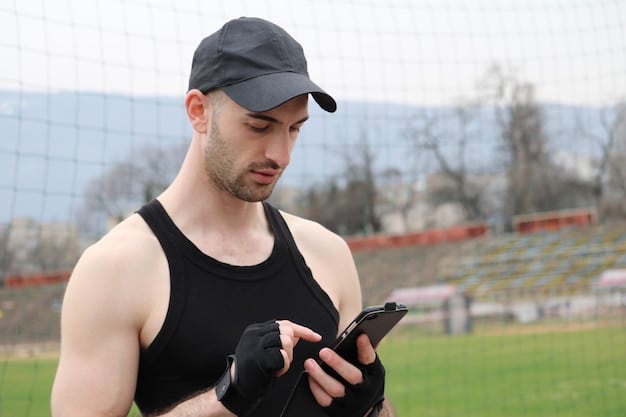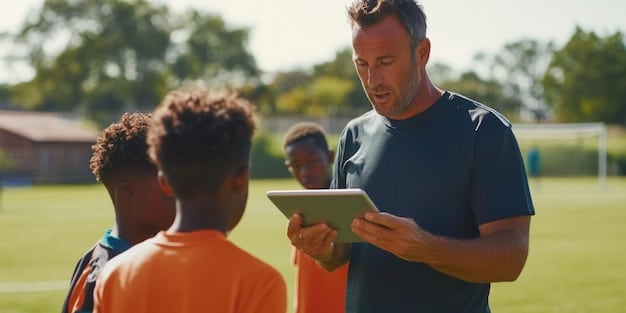The Role of Technology in Youth Sports: Enhancing the Game

The Role of Technology in Youth Sports: How Apps and Gadgets are Changing the Game is transforming training, safety, and engagement, but it also raises concerns about screen time, data privacy, and equitable access for all young athletes.
The Role of Technology in Youth Sports: How Apps and Gadgets are Changing the Game is undeniable. From wearable tech tracking performance to apps facilitating team communication, technology is reshaping how young athletes train, compete, and connect in the world of sports.
Enhancing Training Regimens with Technology
Technology is revolutionizing training for young athletes, providing tools and data that were previously unavailable. This allows for more personalized and effective training programs that cater to individual needs and goals.
Wearable Tech for Performance Tracking
Wearable technology, such as smartwatches and fitness trackers, allows young athletes to monitor various metrics like heart rate, distance covered, and speed. This data provides valuable insights into their performance and helps coaches tailor training plans.
Data-Driven Training Approaches
With the data collected from wearable tech and other sources, coaches can implement data-driven training approaches. This involves analyzing the data to identify areas where athletes can improve and adjusting training accordingly. This leads to more efficient and effective training sessions.
- Real-time feedback: Athletes receive instant data on their performance.
- Personalized training plans: Coaches can tailor workouts based on individual needs.
- Injury prevention: Monitoring metrics can help identify potential risks.
Technology is transforming training in youth sports, offering tools for improving performance, preventing injuries, and creating personalized plans for each athlete.
Improving Player Safety with Advanced Gadgets
Safety is a paramount concern in youth sports, and technology is playing an increasingly vital role in minimizing risks and ensuring the well-being of young athletes. Advanced gadgets and monitoring systems are helping to create safer environments for training and competition.
Concussion Detection and Prevention
Head injuries are a significant concern in contact sports. Technology like smart helmets and mouthguards can detect potential concussions in real-time, alerting coaches and medical staff to take immediate action.
Real-Time Monitoring of Vital Signs
Devices that monitor vital signs such as heart rate, body temperature, and hydration levels can help prevent heatstroke and other health emergencies during intense physical activity. Immediate alerts can be sent when an athlete’s vitals reach dangerous levels.

- Early detection of injuries: Rapid diagnosis prevents further harm.
- Improved emergency response: Medical staff can react quickly to critical situations.
- Data for rule adjustments: Insights into common injury scenarios can refine safety rules.
Technology empowers youth sports with real-time data and advanced tools, enhancing athlete safety through injury detection, vital sign monitoring, and improved response measures during emergencies.
Enhancing Communication and Team Coordination
Effective communication is pivotal for team success. Technology is enhancing team coordination, fostering better connections between players, coaches, and parents, thereby improving overall communication and engagement.
Team Management Apps
Apps designed for team management streamline scheduling, communication, and information sharing. These apps allow coaches to send updates, parents to RSVP to events, and players to stay informed about practices and games.
Video Analysis and Play Review
Video analysis tools enable teams to review game footage, identify strengths and weaknesses, and develop strategies for improvement. Coaches can share clips with players, providing visual feedback to enhance their skills and decision-making.
- Improved information flow: Everyone involved stays updated on schedules and changes.
- Better engagement: Interactive tools encourage participation and involvement.
- Efficient coordination: Less time wasted on logistics and more on training.
Through team management apps and video analysis, technology promotes streamlined communication, facilitates in-depth feedback, and ensures that teams operate more cohesively, resulting in enhanced player performance.
The Impact of Technology on Youth Sports Coaching
Technology has significantly transformed youth sports coaching, providing new tools and data to enhance training strategies, player development, and overall team management. These advancements enable coaches to make informed decisions and tailor their approaches to individual athletes’ needs.
Data Analytics for Strategy Development
Coaches can leverage data analytics to gain insights into player performance, identify areas for improvement, and develop game strategies. Analyzing data from various sources, such as wearable tech and video analysis, helps coaches make objective decisions.
Virtual Training and Remote Coaching
Virtual training platforms and remote coaching tools have expanded access to expert guidance. Young athletes can receive personalized instruction and feedback from coaches regardless of their location, making high-quality training more accessible.

- Objective decision-making: Data-driven insights minimize bias.
- Personalized feedback: Tailored advice enhances performance.
- Increased accessibility: Remote coaching extends expert guidance beyond geographical limits.
Technology is revolutionizing youth sports coaching through data analytics and virtual platforms. Coaches can now develop targeted strategies, deliver personalized feedback, and extend their guidance remotely, ultimately boosting player development.
Potential Downsides and Challenges
While technology offers numerous benefits to youth sports, it’s essential to acknowledge potential downsides and challenges. Concerns about screen time, data privacy, and equitable access need careful consideration to ensure technology is used responsibly.
Increased Screen Time and Sedentary Behavior
Over-reliance on digital devices can lead to increased screen time and sedentary behavior, potentially counteracting the physical benefits of sports. Balancing technology use with traditional training is essential to promote overall health and well-being.
Data Privacy and Security Concerns
The collection and storage of personal data raise privacy and security concerns. Ensuring that data is protected and used ethically is crucial to maintaining trust and safeguarding young athletes’ information.
- Mindful usage: Emphasize the importance of outdoor activities separate from virtual tools.
- Data safeguards: Implement strict guidelines on privacy to protect sensitive information.
- Equitable access: Provide support for underprivileged athletes to bridge technological gaps.
Addressing key challenges such as balancing screen time, ensuring data privacy, and bridging access gaps is vital for responsibly integrating technology into youth sports, safeguarding the well-being and equitable participation of young athletes.
Ensuring Equitable Access to Technology
While technology provides numerous advantages, equitable access remains a critical concern. Ensuring that all young athletes, regardless of their socioeconomic background, have access to these advancements is essential and required.
Community Initiatives and Funding Programs
Community initiatives and funding programs can help provide resources and training to underserved areas. These programs can offer equipment, internet access, and coaching support to ensure that all young athletes have the opportunity to benefit from technology.
Partnerships With Tech Companies
Collaborations between sports organizations and tech companies can help bridge the digital divide. Companies can donate equipment, provide software licenses, and offer training programs to support youth sports in disadvantaged communities.
- Resource allocation: Direct funding towards underprivileged regions to give equal opportunities.
- Company collaborations: Coordinate donations and sponsorships to expand technological accessibility.
- Educational outreach: Initiate training programs to boost digital literacy and tech utilization.
To ensure equitable access to technology in youth sports, investment in community initiatives, establishment of tech company partnerships, and the promotion of digital literacy are essential steps towards bridging the technological divide.
| Key Aspect | Brief Description |
|---|---|
| 📊 Performance Tracking | Wearable tech provides real-time data to optimize training. |
| 🛡️ Enhanced Safety | Gadgets help detect injuries and monitor vital signs during play. |
| 🗣️ Communication Tools | Apps streamline communication and coordination among teams. |
| 🌐 Equitable Access | Initiatives needed to ensure all athletes benefit from tech. |
Frequently Asked Questions
▼
Wearable tech provides real-time data on heart rate, speed, and distance, allowing coaches to tailor training plans to individual needs, optimizing performance and preventing injuries.
▼
Smart helmets have sensors to detect and measure impact force during collisions, alerting coaches to potential concussions immediately, which enables quick response and reduces further harm.
▼
Team management apps streamline communication by allowing coaches to send updates, parents to RSVP for events, and players to stay informed about practices and games, keeping everyone connected.
▼
Potential downsides include increased screen time, sedentary behavior, data privacy concerns, and unequal access. Balancing virtual tools with physical activity and safeguarding athlete data is essential.
▼
Equitable access can be ensured through community initiatives, funding programs, and partnerships with tech companies, providing resources, training, and support for all young athletes, regardless of background.
Conclusion
Technology in youth sports presents a dual narrative: immense potential for enhancing performance, safety, and engagement, coupled with significant challenges like digital equity and data security. Addressing these challenges thoughtfully will unlock a future where technology empowers all young athletes.





